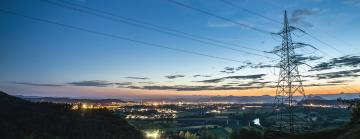SLAC and its partners release a free, easy-to-use platform for understanding and managing electric grids
Called Arras Energy, it can help utilities plan disaster response and integrate renewable energy sources into their grids
By Glennda Chui
The Department of Energy’s SLAC National Accelerator Laboratory and its partners at Hitachi America Energy Solutions Laboratory have released a new open-source software platform for simulating how all the parts of an electric grid work together, along with a graphic interface that makes it much easier for users to understand and apply the results.
Together, these two tools can help utilities harden their distribution systems against extreme weather and wildfires, integrate renewable energy sources like wind and solar into electric grids and set the rates they charge customers, among other things.
The grid simulation platform, called Arras Energy, was developed by DOE with support from the California Energy Commission (CEC). It’s being made available to the energy community by LF Energy as part of a suite of open-source software that utility planners and operators, policymakers, regulators, technology vendors and other interested parties can deploy as-is or adapt to their own needs.
“We are very pleased to deliver this important research tool to support its broader use by utilities,” said David Chassin, who managed the project at SLAC. “Arras Energy provides a rich set of new and important capabilities that utilities need to address the challenges of climate change and ensure a safe, reliable, secure and resilient electricity delivery system.”
The web interface, called GLOW, was developed by Hitachi with funding from the CEC. GLOW is designed to make Arras Energy more intuitive and easier to use so more people can take advantage of it.
“GLOW democratizes the software platform,” said Panitarn (Joseph) Chongfuangprinya, a principal research scientist at Hitachi. “People without experience will find it much easier to use than the old way of typing command codes into a computer, so it will increase the user base.”
Arras Energy is based on 15 years of development at DOE – initially as a research platform for simulating future grid scenarios and more recently as a high-performance commercial platform to meet the needs of California utilities. It’s many times faster in running simulations than the original DOE research platform, and it’s significantly cheaper to run. The team anticipates significant reductions in cloud computing costs.
LF Energy is an initiative of the Linux Foundation. The research version of Arras Energy, known as GridLAB-D, was initially developed at DOE’s Pacific Northwest National Laboratory.
This project was funded by the DOE Office of Energy Efficiency & Renewable Energy.
Contact
For questions or comments, contact the SLAC Office of Communications at communications@slac.stanford.edu.
About SLAC
SLAC National Accelerator Laboratory explores how the universe works at the biggest, smallest and fastest scales and invents powerful tools used by researchers around the globe. As world leaders in ultrafast science and bold explorers of the physics of the universe, we forge new ground in understanding our origins and building a healthier and more sustainable future. Our discovery and innovation help develop new materials and chemical processes and open unprecedented views of the cosmos and life’s most delicate machinery. Building on more than 60 years of visionary research, we help shape the future by advancing areas such as quantum technology, scientific computing and the development of next-generation accelerators.
SLAC is operated by Stanford University for the U.S. Department of Energy’s Office of Science. The Office of Science is the single largest supporter of basic research in the physical sciences in the United States and is working to address some of the most pressing challenges of our time.






